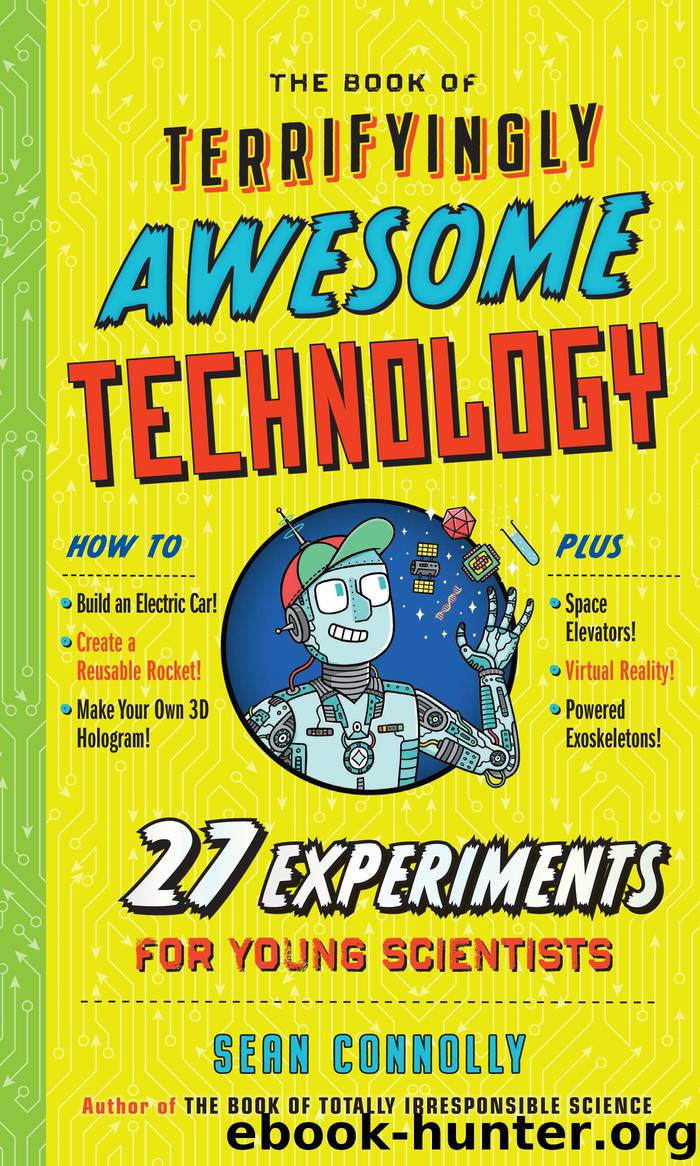The Book of Terrifyingly Awesome Technology by Sean Connolly

Author:Sean Connolly
Language: eng
Format: epub
Publisher: Workman Publishing Co., Inc.
Published: 2019-06-15T00:00:00+00:00
They have identified those nucleotides by letter: A (adenine), C (cytosine), G (guanine), and T (thymine). If you imagine pulling the DNA rungs apart, you’d find how those same four nucleotides form an incredibly long series of letters. Here’s where scientists figure they’d hit pay dirt. They can look at the long string of chemicals of just one half of the DNA to see its chemical sequence, or “genetic code.”
Aha! Eureka! We’ve come across the word gene, sort of. That’s familiar!
Let’s tie things up now. A gene is a section of DNA that is responsible for developing the makeup of an organism—how it looks and also how it behaves. And genes are what get passed on from both of your parents, so you might have inherited your dad’s curly hair, your mom’s gift for singing, and a good sense of humor from both sides.
That’s a big introduction to make it easier to understand an even newer development: genome technology.
How Life Is Better
The wider understanding of genes and inheritance (how genes are passed on to the next generation) has been a huge help to doctors and other medical professionals. Understanding a patient’s “genetic makeup” helps to identify diseases or even the likelihood of acquiring certain diseases later on.
Long before genetics were fully understood, it was already observed that certain groups of people were more likely than others to contract particular diseases. For example, doctors were able to conclude that a blood disease called sickle cell anemia was most common among people with African or southern European ancestry.
That type of “early warning” has served doctors well. The much more detailed information from recent advances such as the Human Genome Project (more on that soon) will help them identify and treat far more diseases.
All of which leads to the subject of “genome editing.” This is a way of targeting specific genes (possibly disease-causing) and modifying them so that the risk is reduced. In one technique called CRISPR, for instance, scientists can “cut” a sequence in an organism’s DNA using a chemical. It’s called “editing” the genome to remove or alter a sequence. When the cell repairs the cut, the DNA remains in the new, “edited” form with the changes in place. This technique can treat diseases such as leukemia, a form of cancer that affects the blood. It could also help prevent future generations inheriting a disease trait.
Genome
An organism’s complete set of DNA, including all of its genes. Each genome contains all the information needed to build and maintain that organism.
Download
This site does not store any files on its server. We only index and link to content provided by other sites. Please contact the content providers to delete copyright contents if any and email us, we'll remove relevant links or contents immediately.
CLICK'D by Tamara Ireland Stone(1545)
Baby Bird by Seven Rue(1419)
Minecraft by Mojang Ab(1414)
Olivia Twisted (Entangled Teen) by Vivi Barnes(1398)
The Game of Lives by James Dashner(1377)
The Rule of Thoughts by James Dashner(1309)
Getting Started with the micro:bit by Wolfram Donat(1279)
Flynn's Log 1 by Stone Marshall(1160)
The Mortality Doctrine 01: The Eye of Minds by James Dashner(1157)
Mission Python by Sean McManus(1121)
A Warning by Anonymous(1117)
The Rule of Thoughts (Mortality Doctrine, Book Two) by James Dashner(1094)
Girls Who Code: Learn to Code and Change the World by Reshma Saujani(1008)
CODE by Petzold Charles(1000)
Only You Can Save Mankind by Pratchett Terry(956)
The Memory Wall by Lev AC Rosen(917)
TBH, This Is So Awkward by Lisa Greenwald(913)
App of the Living Dead by Kim Harrington(877)
The Code Book - HOW TO MAKE IT, BREAK IT, HACK IT, CRACK IT by Simon Singh(867)
